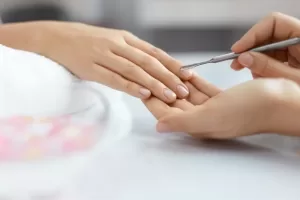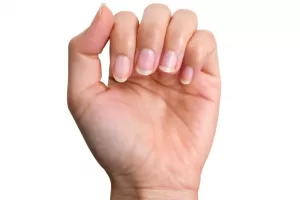10 things fingernails reveal about your health
Changes in the appearance of your fingernails can be caused by many different health issues. A lot of these problems are not of major concern, but some may be more serious, and need to be recognised and diagnosed. So, here are some of the nail problems people commonly ask their doctors about, as well as rarer conditions that can occur from time to time.
Ridging of the nails
Horizontal ridges or indentations across the nails, also known as “Beau’s lines”, can occur if the normal growth of the nail has been interrupted for a period of time, due to infection, malnutrition or a significant systemic illness. However, local injury or infection of the nail or nail-bed itself may also be to blame.
Nail infections
- Fungal nail infections are common. Whilst more often seen in the toenails, occasionally the fingernails can be affected. Typical symptoms include white or brownish discolouration of the nails, as well as breaking, crumbling or thickened nails. The diagnosis can be confirmed by sending nail clippings to a lab for analysis. This is important before treatment starts, as sometimes the problem is not actually a fungal infection, but another condition, such as psoriasis. If a fungal nail infection is mild, a topical antifungal varnish may work, but if a lot of the nail is involved or several nails are affected, then oral antifungals may need to be considered. Oral antifungal medications can have bad side effects, so it’s important to discuss the options fully with your doctor.
- Paronychia is a bacterial infection that causes redness and soreness around the nail, and often a small collection of pus is visible under the skin near the cuticle. It may need treatment with oral antibiotics, so medical attention should be sought.
Splitting nails
If your hands and nails frequently get wet- for example, due to housework or a job that requires regular hand washing- splitting and peeling of the layers of the nail may occur. The best solution is to wear rubber gloves when washing the dishes or doing other chores that involve water, to moisturise the skin and nails regularly and to use a hand sanitiser whenever hand-washing is not essential.
Other causes of splitting nails include picking at the nails or trauma to the nail (e.g. from overly frequent or aggressive manicure treatments)
Trauma to the nails
Any repeated trauma or injury to the nails can cause them to split, break and change in texture. Repeated application and removal of false nails or long-lasting nail polish can cause dryness, splitting and discolouration of the nails, particularly if over-vigorous buffing or filing techniques are used. This, in turn, can leave nails more susceptible to infections. If you’re having nail polish or false nails applied or removed, ensure the salon is using appropriately gentle techniques.
Pitting of the nails
Psoriasis is a skin condition that causes a scaly pink rash on the body and scalp. But sometimes it can also cause “pitting”- tiny pits or hollows in the nails. Pitting of the nails may also happen in psoriatic arthritis, as well as other autoimmune and connective tissue disorders.
Melanoma
Melanoma is a serious form of skin cancer that usually presents as a dark-coloured, irregular or changing mole somewhere on the body. It may itch or bleed. But sometimes Melanoma can develop under a nail. If you notice a dark or unusual spot forming under a fingernail or toenail, you should see your doctor urgently.
Splinter Haemorrhages
These are tiny bleeds that look like brown lines or splinters under the nail. If the finger has been injured recently, that is the most likely cause. But in some cases, splinter haemorrhages are caused by conditions such as bacterial endocarditis (a serious bacterial infection of the heart valves) or vasculitis (inflammation of blood vessels, which can happen in a number of inflammatory conditions such as Lupus and Rheumatoid Arthritis). If you notice splinter haemorrhages, it’s important to speak to a doctor as soon as possible, to get tested for underlying conditions.
Spoon shaped nails or “koilonychia”
This unusual and rare symptom is when the edges of the nails curve upwards and inwards- so the nail could almost carry a drop of water! It is a sign of severe iron deficiency anaemia but can also be caused by an underactive thyroid or heart disease, in rare cases.

Terry’s Nails
Any significant long term illness – such as chronic failure of the kidneys, liver or heart, can lead to changes in the appearance of the nails. They may become white or pale, with pinkish tips- a condition sometimes known as “Terry’s nails”.
Clubbing
In clubbing of the fingers (or toes) there may be widening and increased curvature of the nails, a more pronounced angle between the finger and the nail, a boggy feeling if the nails are pressed, and a bulging appearance to the finger tips. Clubbing of the fingers can occur in a variety of lung, heart and bowel conditions as well as in some blood disorders. It can develop over weeks or years, depending on the underlying cause. As many of the potential causes can be very serious, it’s a symptom that should be assessed promptly by a doctor.
If you are worried about any of the above nail conditions, you should speak to your doctor.
Getting a Mental Health Care Plan in Australia: Your Guide
Getting a Mental Health Care Plan in Australia: Your Guide Mental health matters—and if you’re feeling overwhelmed, anxious, or down, a mental health care plan can help. But what is it, and how do [...]
UTI Symptoms and Treatment: What You Need to Know
UTI Symptoms and Treatment: What You Need to Know Urinary Tract Infections (UTIs) are common, uncomfortable, and often disruptive. But what exactly are the signs to watch for, and how can you get relief [...]
Free Mental Health Care Plan Online | Bulk-Billed by Qoctor
Free Mental Health Care Plan Online | Bulk-Billed by Qoctor Discover how to get a free, bulk-billed Mental Health Care Plan (MHCP) in Australia through Qoctor's telehealth service. Accessing [...]




